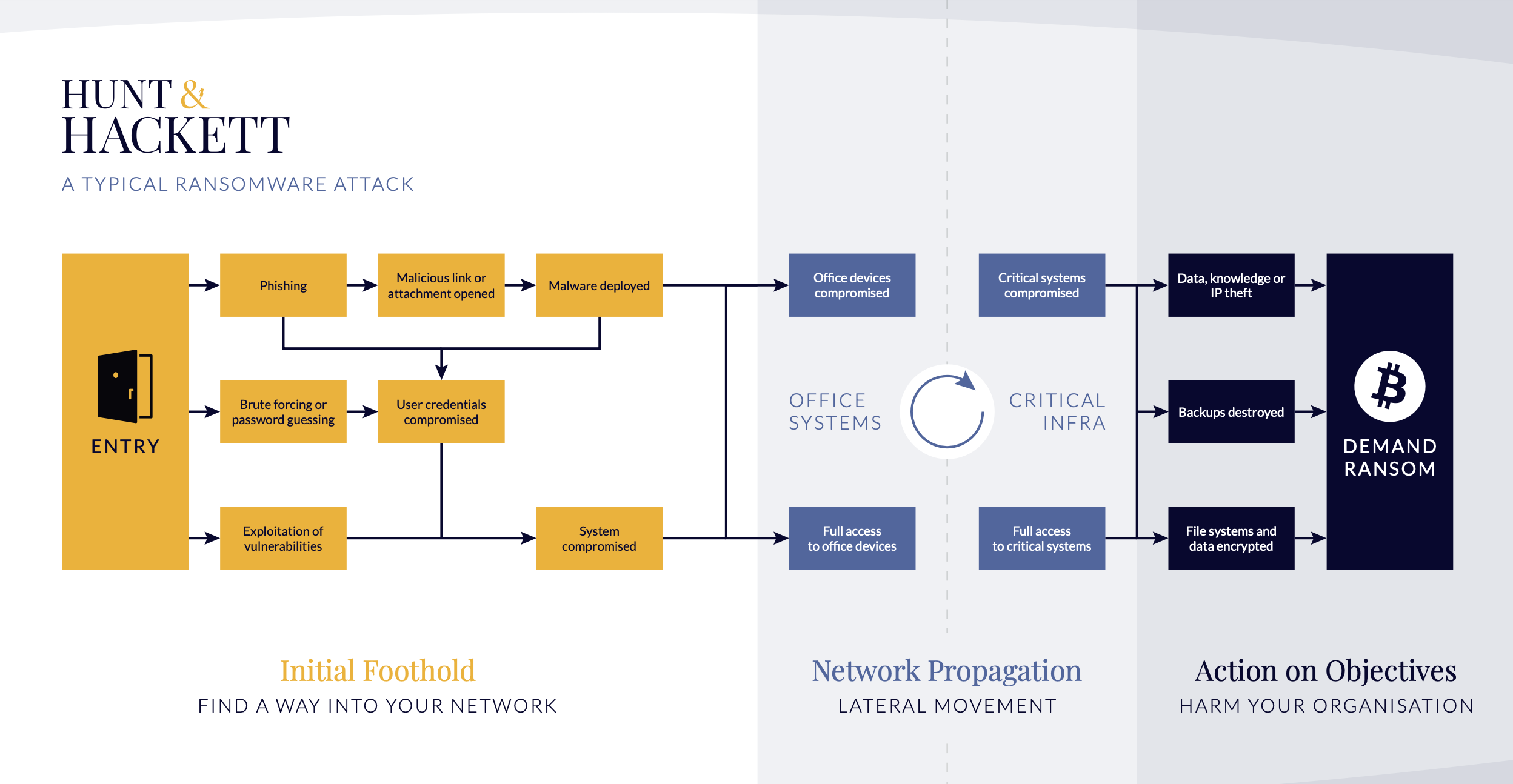Responding to Ransomware
Crisis Workshop | March 14
Learn more about our CyberConnect series
In 2024, there is widespread understanding of the threats posed by ransomware. Yet, despite increased awareness, many organisations lack the experience and in-house knowledge to deal with such an attack if one does occur. When an organisation is hit by ransomware, there are lots of important decisions to be made and very little time to do so. How can you restore normal operations and safeguard your organisation's reputation? And most importantly - should you pay the ransom?
During this interactive crisis workshop, Hunt & Hackett's security experts will guide you through the process of responding to a ransomware attack. Our team has accumulated a wealth of knowledge on this topic, having participated in many high-profile ransomware investigations in the past. Now we are pleased to share our insights with the Hunt & Hackett community, ensuring you are well prepared if such an incident arises at your own organisation.
Please note that places for this workshop are limited. Sign up now to secure your spot!
Practical Information
- When:
Thursday, March 14
15:30 - 18:00 - Where:
Hunt & Hackett's office
New Babylon
Anna van Buerenplein 46
The Hague
Find on Google Maps
Programme
- 15:00 – 15:30
Arrival - 15:30 – 16:30
Hunt & Hackett's security experts will guide you through the process of responding to a ransomware attack, focusing on the all-important question: To pay the ransom, or not to pay? During this 'choose your own adventure' workshop, the decisions you make will influence the course of the session. - 16:30 -17:00
You will have the chance to share your own experiences and best practices. This is also a great opportunity to ask questions and benefit from the insights of Hunt & Hackett's security experts. - 17:00 – 17:30
We will conclude with some key takeaways and actionable recommendations that you can take back to your own organisation. - 17:30 – 18:00
Borrel

Registration
Ransomware in 2024
The Definitive Guide
Ransomware is defined as "a type of malicious software designed to block access to a computer system until a sum of money is paid." In general, ransomware can be distributed randomly or in a (semi-)targeted manner. The latter can be aimed at either individuals, or to specific businesses, organisations, or government agencies. Ransomware attacks, and targeted ransomware in particular, can result in serious consequences for the victim, such as the disruption of operations, financial loss, or the loss of sensitive or proprietary information. The motivations behind these attacks vary, but most often the attackers are seeking to extract a large sum of money from the victim. In some cases, the attackers may also be motivated by political or ideological goals, such as causing disruption or destruction.
Ransomware Actors
Ransomware actors come in all shapes and sizes. They can be well-organized and even state-funded Advanced Persistent Threat (APT) groups, politically or socially motivated hacktivist teams, or even bored individuals with questionable moral standards looking to stir chaos and gain financial advances. Some of them focus primarily on ransomware attacks, while others specialize in, say, espionage, but occasionally engage in ransomware attacks. Hunt & Hackett currently tracks 97 distinct ransomware actors.
When a ransomware attack takes place, it is not always obvious who is behind it. Often times, attacks and the malware used remain unattributed to any specific known or emerging group. Based on the available information Hunt & Hackett has compiled, Russia, China and Iran have the highest number of groups operating in the business of ransomware. Even though their main targeted countries vary, and social and political events often change the dynamics, in general the United States, the United Kingdom and Germany experience the highest number of attacks.
A Typical Ransomware Attack

Groups that have been observed to engage in ransomware attacks tend to use a wide variety of techniques, but Phishing, using Command and Scripting Interpreters, Obfuscating Files or Information, enticing User Execution and using Encrypted Channels are among the most utilized methods. The picture above shows the phases of a typical ransomware attack. This includes the initial foothold phase, during which the attackers gain access to the targeted network and start establishing their presence. During the next phase, network propagation, the attackers gain access to more devices or even the whole infrastructure. The last phase – action on objectives – is what is commonly thought of as the attack itself. This is when the attackers conduct the actual information theft, encryption of files, destruction, or all of the above. These moves then allow them to demand ransom from the organization in exchange for the stolen or encrypted data. However, it is worth noting that this is only one way of conducting a ransomware attack, and more variations have been continuously emerging. For instance, triple extortion attacks would involve additional steps, most often DDoS attacks and publication of stolen data. The following section will explore the different variations to better understand how ransomware attacks can play out.
Interested in learning more? Read our definitive guide to ransomware at the link below.